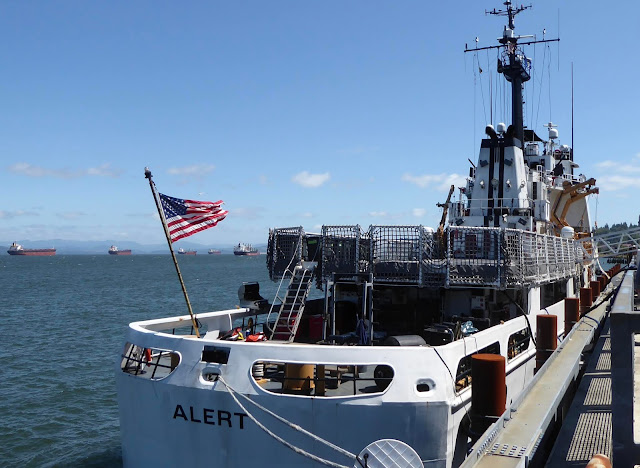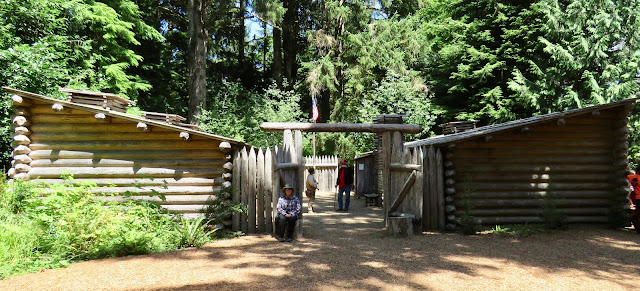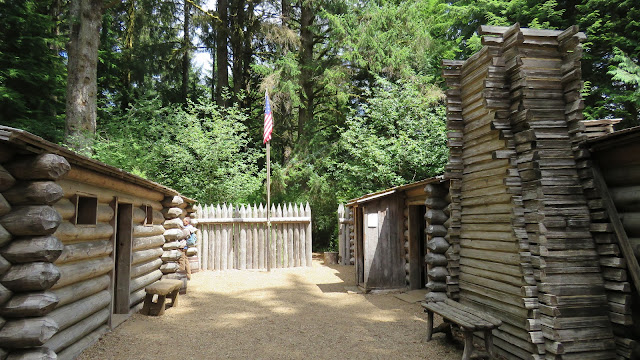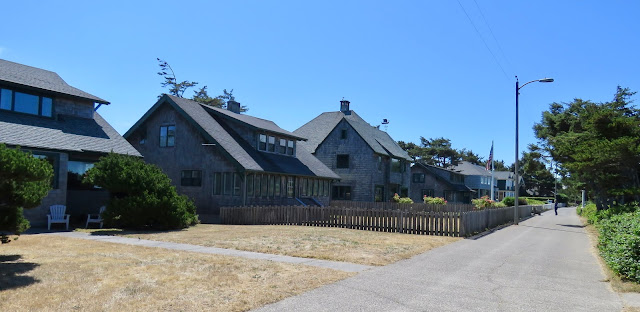
“Great men are meteors designed to burn so that the earth may be lighted.” Napoleon Bonaparte
CAROL WRITES: From our rural campground in Washington State, we deviated south and west to our last stop on the Pacific Ocean—the tiny town of Astoria, Oregon, on the Columbia River.
Named after early American fur trader John Jacob Astor, Astoria was a good jumping-off point from which to visit several locales associated with the Lewis and Clark Expedition.
The Lewis and Clark Expedition was the brainchild of President Thomas Jefferson, who in 1803 directed Meriwether Lewis and William Clark to organize a cadre of explorers who would be tasked to explore the Missouri River to its source and from there to find the most direct water route to the Pacific Ocean.
Led by Lewis and Clark, the 31 men of the Corps of Discovery were ordered by President Jefferson to make scientific and geologic observations “with great pains and accuracy” as they explored the vast and as yet uncharted Northwest. President Jefferson was also keen to receive detailed descriptions of the culture of the Indian tribes that the expedition met along their route. At Fort Mandan in what is now North Dakota, Lewis and Clark engaged the services of Indian guide Sacagawea and her husband Touissant Charbboneau, accompanied by their infant son, Jean Baptiste.
A short drive up a windswept hill above picturesque Astoria led us to the Astoria Column, a jewel of a monument dedicated to Astoria’s early explorers and settlers. The 125-ft tower was decorated with pictures that celebrated important moments in Northwest history from 1792 to 1818. Over the next several days, my aching thighs made me second-guess the wisdom of climbing the narrow 164-step spiral staircase for the view at the top; however there was no denying that the view from on high really was superb on this clear sunny day.
From our vantage point, the surrounding view of the town of Astoria and the nearby Astoria-Megler Bridge, which spanned the Columbia River to Washington State, was a jaw-dropper. This bridge is the longest continuous truss bridge in North America.
Harbor-side down below, Astoria exhibited a somewhat sleepy pace of Coast Guard harbor duties—at least on this calm summer day.
Cargo ships that transported heavy goods and materials, such as grain and lumber, were anchored in a wide stretch of the Columbia River where they awaited space to dock upriver in Longview.
LEWIS AND CLARK EXPEDITION
Lewis and Clark arrived at the mouth of the Columbia River in November1805. With harsh winter weather fast approaching, there was an urgent need to find winter quarters to prepare for the spring start of the arduous journey back east. From December 1805 to March 1806 the Corps of Discovery braved the winter elements at Fort Clatsop.
Here game was plentiful and the indigenous Clatsop People were friendly. Nothing remains intact of the original fort; however, this excellent replica based on William Clark’s journal was said to be situated within yards of the actual site.
The geography around the mouth of the Columbia River naturally creates some very interesting points of view. Cape Disappointment, located in the extreme southwestern corner of Washington State was just such a place. British fur trader John Meares named this area Cape Disappointment after he failed to discover the mouth of the Columbia River during a storm.
At the edge of the continent, Cape Disappointment is one of the windiest and foggiest locations on the West Coast. The North Head Lighthouse, which was established in 1898, is still functioning.
Cape Disappointment marked the furthest point west for the Lewis and Clark Expedition. The Lewis and Clark Interpretive Center offered more than enough historical information about 2-1/2 years of discoveries made by Lewis and Clarks’s Corps of Discovery.
Toward the end of our stay in Astoria, we took some time to head south to the resort city of Seaside, Oregon. Al had read about a 1-1/2-mile paved promenade along the beach that would offer a good opportunity to get some miles on the trackers. The houses were eye-pleasing and the flowers were outstanding!
In Seaside, the beach cottage concept was taken to a whole new level.
During our visit, Tillamook Head greeted us with a typical Oregon coast fog show.
There was even a Lewis and Clark connection in Seaside that has been preserved in a residential area of the beachfront. At the Salt Works
five members of the Lewis and Clark crew boiled seawater day and night for several weeks to produce much-needed salt that was used to preserve meat for the return trip east.
HARBOR DEFENSES OF THE COLUMBIA RIVER
At Fort Columbia State Park, high atop a hill with a view of the Columbia River estuary, we explored one of the most intact coastal defensive forts on the West Coast.
In times of war the mouth of the Columbia River was of obvious strategic importance. Established by the Army in 1896, Fort Columbia supplied essential artillery defense for the harbor and as such was fully manned and operational for two wars.
The gun batteries that once offered an unobstructed view of the Columbia River,
and other preserved buildings provided a realistic peak into the life of the times.
In fact, in June 1942, a Japanese submarine shelled the harbor defenses of the Columbia! We have many reasons to give a heartfelt thanks to the men and women who participated in the coastal defense of our country.
Situated on the south side of the Columbia River, a similar military installation named Fort Stevens guarded the mouth of the Columbia River during the years between the Civil War and 1947. Gun batteries similar to those at Fort Columbia were also at Fort Stevens. Al and I had clear memories of how much fun our kids had running around the massive concrete gun batteries during our 1989 visit when we camped at the Fort Stevens State Park campground.
Three decades down the road after our 1989 visit, the century-old skeleton of the Peter Iredale, which ran ashore in thick fog, still lies entombed in the sand at the water’s edge on Fort Stevens.
Two years ago in a campground outside Omaha, Nebraska, the couple next to us were in the early days of an ambitious plan to follow along the route of the Lewis and Clark Expedition—all the way to the Pacific Ocean. They were wrapped up in this adventure to the point where when they arrived at a particularly notable stop on the route, they took time to dress in costumes of the period! I trust they had a suitable celebration when they arrived at Lewis and Clark’s western terminus near present-day Astoria.
Interesting folks we meet on the road…
A themed travel route could be an interesting RV adventure, but for now we will stick to Al’s most excellent plans.
“It always seems impossible, until it’s done. Nelson Mandela





























No comments:
Post a Comment